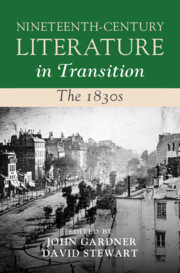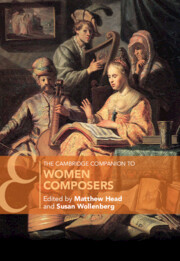781 results
10 - Science
-
-
- Book:
- The Conservative Effect, 2010–2024
- Print publication:
- 27 June 2024, pp 326-353
-
- Chapter
- Export citation
5 - Health
-
-
- Book:
- The Conservative Effect, 2010–2024
- Print publication:
- 27 June 2024, pp 131-156
-
- Chapter
- Export citation
Myth 7 - That Darwin Was a Recluse, and a Theoretician Rather Than a Practical Scientist
-
-
- Book:
- Darwin Mythology
- Published online:
- 30 May 2024
- Print publication:
- 06 June 2024, pp 80-90
-
- Chapter
- Export citation
Chapter 8 - Steam and Iron in the 1830s
-
-
- Book:
- Nineteenth-Century Literature in Transition: The 1830s
- Published online:
- 30 May 2024
- Print publication:
- 06 June 2024, pp 170-190
-
- Chapter
- Export citation
Chapter 1 - On the Eve
-
-
- Book:
- Nineteenth-Century Literature in Transition: The 1830s
- Published online:
- 30 May 2024
- Print publication:
- 06 June 2024, pp 17-37
-
- Chapter
- Export citation
4 - Origins
-
- Book:
- The Archaeology of Southern Africa
- Published online:
- 15 May 2024
- Print publication:
- 06 June 2024, pp 53-84
-
- Chapter
- Export citation

Nineteenth-Century Literature in Transition: The 1830s
-
- Published online:
- 30 May 2024
- Print publication:
- 06 June 2024
14 - The Reverse Spider-Man Principle
- from Part III - Platform Governance
-
-
- Book:
- Media and Society After Technological Disruption
- Published online:
- 16 May 2024
- Print publication:
- 23 May 2024, pp 161-176
-
- Chapter
-
- You have access
- Open access
- HTML
- Export citation
Chapter 32 - Faust and Modernity
- from Part VI - Goethe’s Lasting Significance
-
-
- Book:
- Goethe in Context
- Published online:
- 16 May 2024
- Print publication:
- 23 May 2024, pp 313-322
-
- Chapter
- Export citation

The Cambridge Companion to Women Composers
-
- Published online:
- 23 May 2024
- Print publication:
- 30 May 2024
Chapter 14 - Technologies of the Book
- from Part III - The Practical Arts
-
-
- Book:
- The Cambridge Companion to William Morris
- Published online:
- 03 May 2024
- Print publication:
- 23 May 2024, pp 188-200
-
- Chapter
- Export citation
Chinese Immigrant Caregivers: Understanding Their Unmet Needs and the Co-Design of an mHealth App
-
- Journal:
- Canadian Journal on Aging / La Revue canadienne du vieillissement , First View
- Published online by Cambridge University Press:
- 17 May 2024, pp. 1-8
-
- Article
-
- You have access
- HTML
- Export citation
1 - Introduction
-
- Book:
- The New Experts
- Published online:
- 09 May 2024
- Print publication:
- 16 May 2024, pp 1-16
-
- Chapter
- Export citation
Chapter 10 - Technological Fantasies
-
-
- Book:
- The Cambridge Companion to American Utopian Literature and Culture since 1945
- Published online:
- 09 May 2024
- Print publication:
- 16 May 2024, pp 185-200
-
- Chapter
- Export citation
Scoping user needs for an online nutrition education resource for older adults
-
- Journal:
- Proceedings of the Nutrition Society / Volume 83 / Issue OCE1 / April 2024
- Published online by Cambridge University Press:
- 07 May 2024, E107
-
- Article
-
- You have access
- Export citation
AI-Inclusivity in Healthcare: Motivating an Institutional Epistemic Trust Perspective
-
- Journal:
- Cambridge Quarterly of Healthcare Ethics , First View
- Published online by Cambridge University Press:
- 29 April 2024, pp. 1-15
-
- Article
-
- You have access
- Open access
- HTML
- Export citation
25 - Communicative Gesturing in Interaction with Robots
- from Part V - Gestures in Relation to Interaction
-
-
- Book:
- The Cambridge Handbook of Gesture Studies
- Published online:
- 01 May 2024
- Print publication:
- 18 April 2024, pp 641-660
-
- Chapter
- Export citation
Chapter 13 - Extending Extension’s Outreach and Engagement with Social Media
- from Part III - Looking Ahead: Emerging Issues and Trends
-
-
- Book:
- Extension Education and the Social Sciences
- Published online:
- 28 March 2024
- Print publication:
- 04 April 2024, pp 267-285
-
- Chapter
- Export citation
A Folsom Foreshaft from the Blackwater Draw Site
-
- Journal:
- American Antiquity / Volume 89 / Issue 2 / April 2024
- Published online by Cambridge University Press:
- 02 April 2024, pp. 263-278
- Print publication:
- April 2024
-
- Article
-
- You have access
- Open access
- HTML
- Export citation
Chapter 2 - Black Steam
- from Part I - Mechanical Automata
-
-
- Book:
- Victorian Automata
- Published online:
- 15 March 2024
- Print publication:
- 28 March 2024, pp 48-69
-
- Chapter
- Export citation



